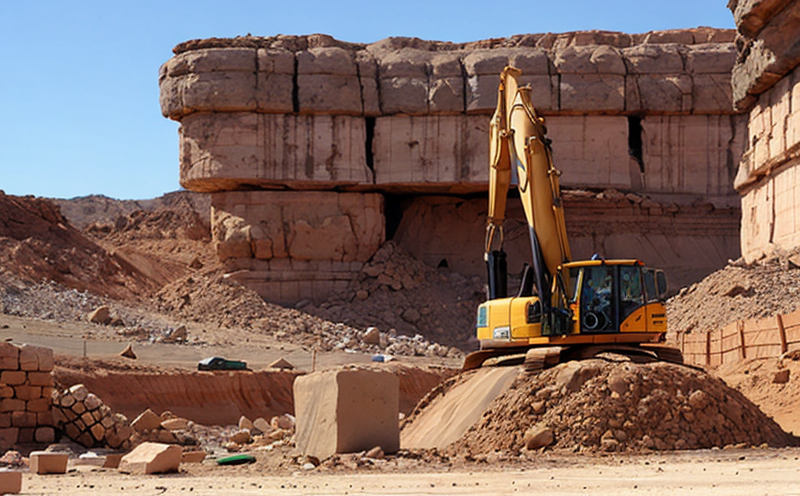DIN 22022 Geological Core Sampling Rock Testing
The DIN 22022 standard is pivotal in the field of mining testing, particularly within rock mechanics and geotechnical testing. This method provides a standardized approach to sampling and testing geological cores extracted from mines and quarries. The primary objective is to ensure that structural integrity is maintained during excavation processes and to support the design of safe and efficient underground structures.
The standard covers various aspects including the selection, handling, preparation, and testing of rock core samples. It ensures that tests are conducted under controlled conditions to yield accurate results. Compliance with DIN 22022 is crucial for mining companies aiming to meet international standards and ensure safety in operations. This includes understanding the mechanical properties of rocks such as compressive strength, tensile strength, shear strength, and modulus of elasticity.
The testing process involves several key steps:
- Sampling: Proper selection of rock core samples that represent the intended test specimens.
- Handling: Careful handling to avoid damage or alteration of the sample properties.
- Preparation: Preparation of the sample for testing, including trimming and grinding as necessary.
- Testing: Application of appropriate mechanical tests to determine the desired physical properties.
The results from these tests are essential for designing safe mine structures, planning excavation strategies, and ensuring compliance with international standards. The DIN 22022 method is widely used in mining testing due to its reliability and consistency across different environments and rock types.
Compliance with this standard ensures that the extracted rocks meet specific quality criteria, which is critical for both safety and efficiency in mining operations. It helps in identifying potential risks associated with geological structures, thus enabling proactive mitigation measures.
Why It Matters
The importance of DIN 22022 cannot be overstated in the context of mining testing and safety. By adhering to this standard, mines can ensure that their operations are conducted safely, efficiently, and in compliance with international regulations. This is particularly crucial given the high stakes involved in underground mining activities.
The use of DIN 22022 helps in:
- Ensuring structural integrity during excavation processes.
- Promoting safe and efficient mine design.
- Maintaining compliance with international standards.
- Avoiding potential risks associated with geological structures.
The standard's implementation not only enhances the reliability of testing results but also supports decision-making in mining operations. It provides a structured approach to rock mechanics and geotechnical testing, ensuring that all stakeholders have access to accurate data when planning and executing projects.
In summary, compliance with DIN 22022 is essential for maintaining safety standards and operational efficiency in the mining industry. By adhering to this standard, mines can ensure that their operations are conducted safely and in compliance with international regulations.
Industry Applications
- Mining Operations: Ensuring safe excavation and structural integrity of mine tunnels and shafts.
- Construction Projects: Evaluating the stability and load-bearing capacity of rock foundations in construction projects.
- Geotechnical Engineering: Assessing the suitability of rock for various engineering applications.
- R&D: Studying the physical properties of rocks to improve mining techniques and equipment.
The DIN 22022 method is widely used in these sectors due to its reliability and consistency, making it a cornerstone in geotechnical testing.
Use Cases and Application Examples
DIN 22022 plays a critical role in various use cases within the mining sector. Here are some examples:
- Excavation Planning: Assessing rock properties to plan safe excavation strategies.
- Mine Design: Ensuring that mine structures can withstand the stresses of extraction processes.
- Risk Management: Identifying potential geological risks before they become safety hazards.
- New Technology Testing: Evaluating new mining equipment and techniques using standardized testing methods.
In each case, DIN 22022 provides a robust framework for conducting accurate and consistent tests. This ensures that all stakeholders have reliable data to make informed decisions about mine operations.
For instance, in excavation planning, the standard helps engineers select appropriate rock types and design tunnels that can withstand the pressure of extraction without collapsing. In mine design, it ensures that structures are built with sufficient strength to support the weight of overlying rocks. Risk management benefits from early identification of potential geological issues through thorough testing.
Additionally, DIN 22022 supports the evaluation of new technologies and equipment by providing a standardized method for testing their performance against rock samples. This helps in identifying any shortcomings or areas for improvement before full-scale implementation.





